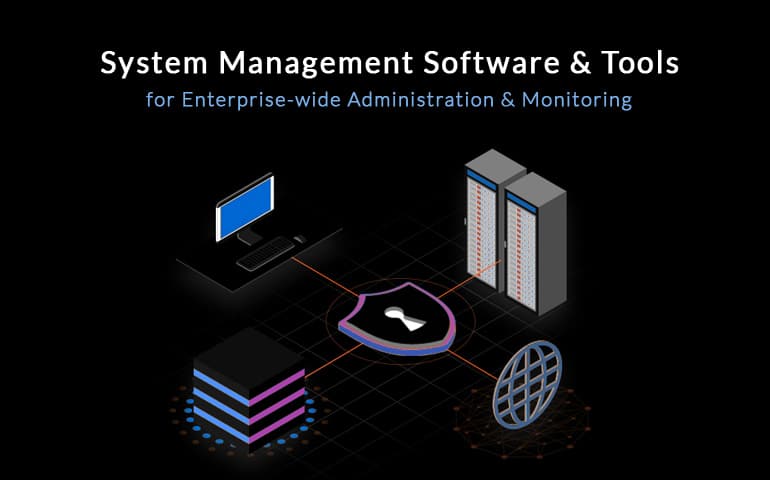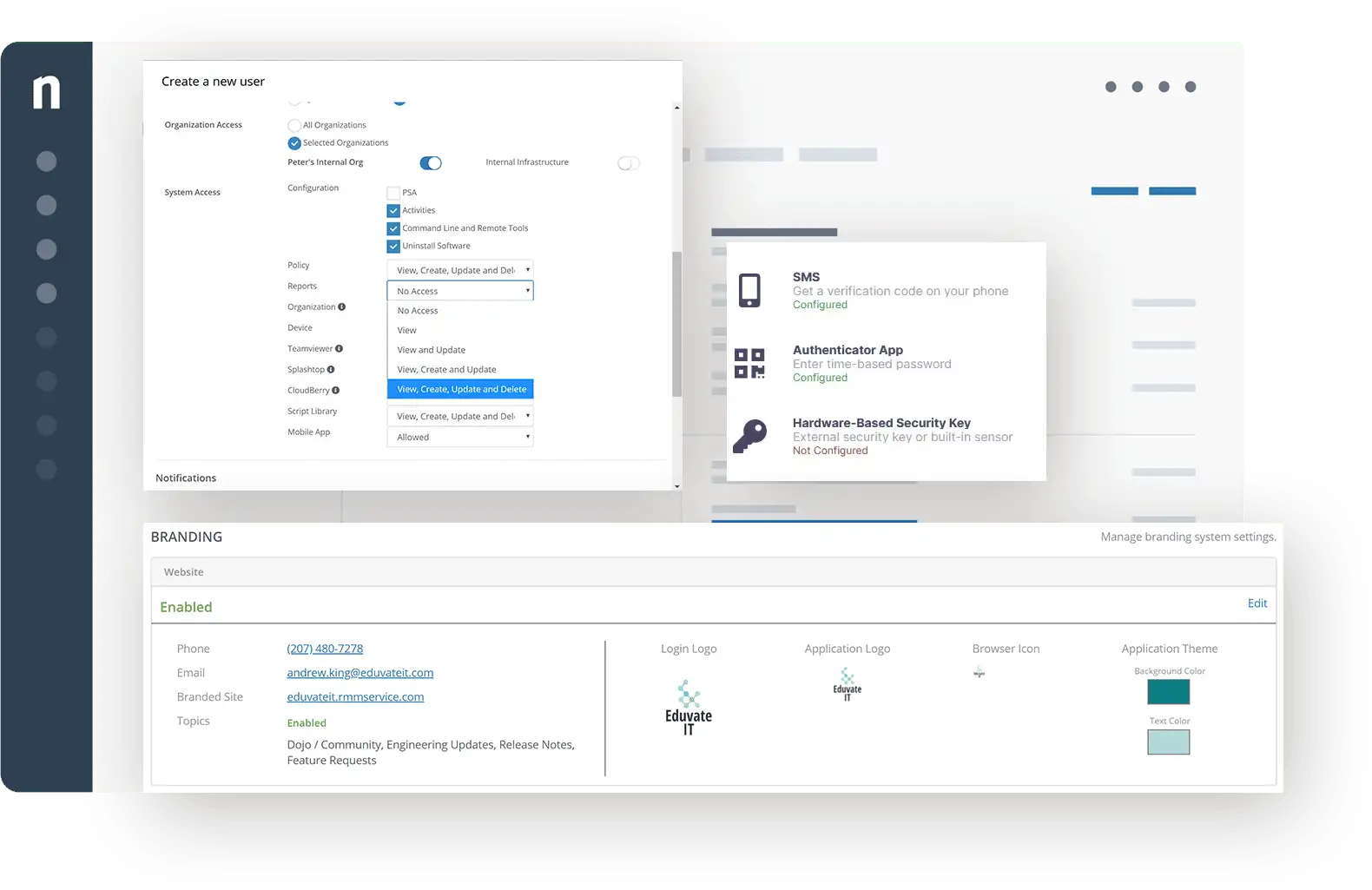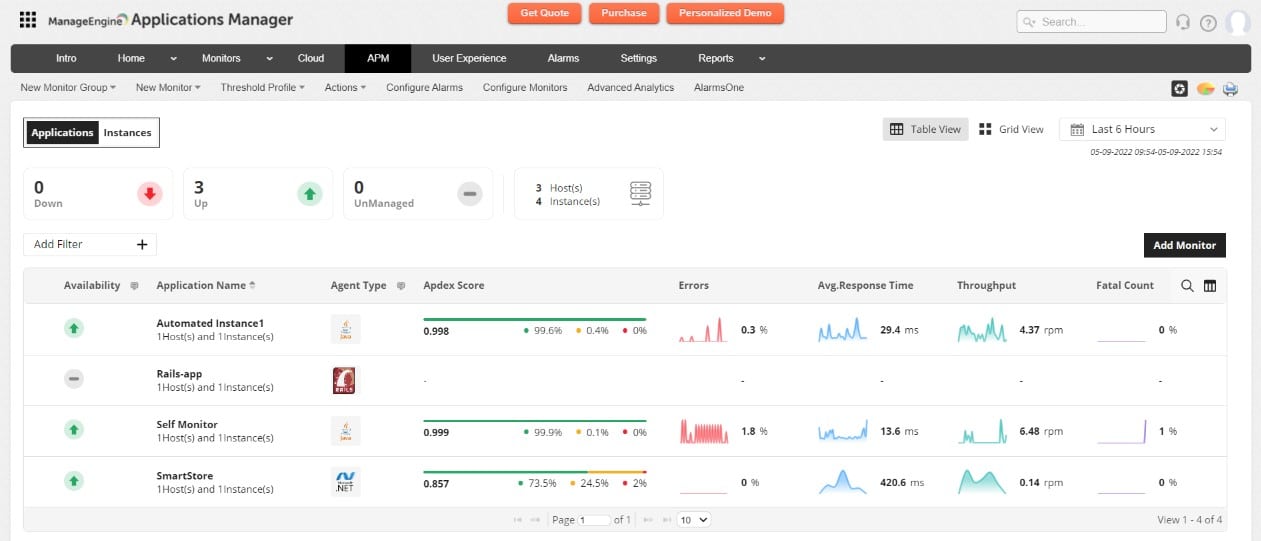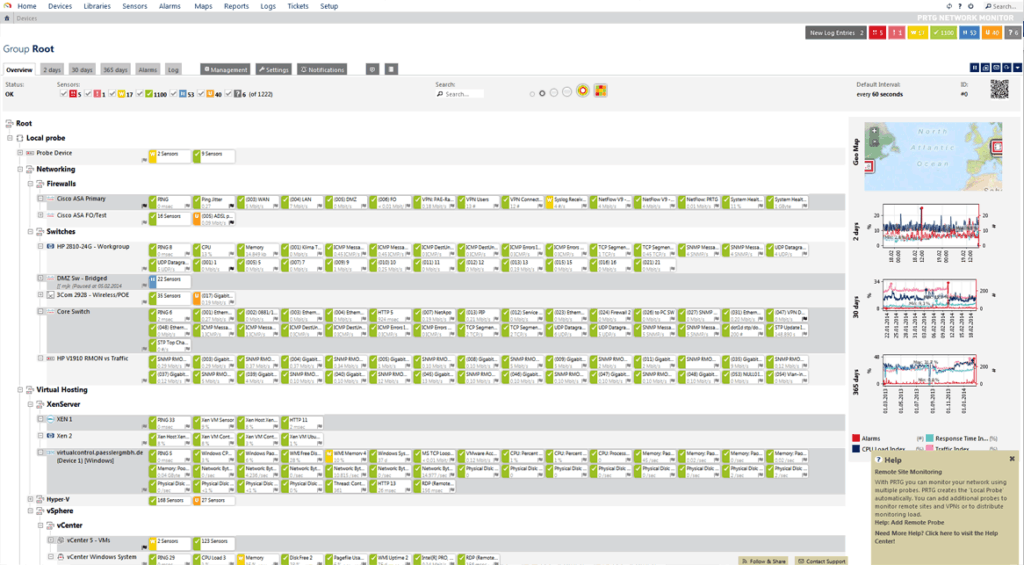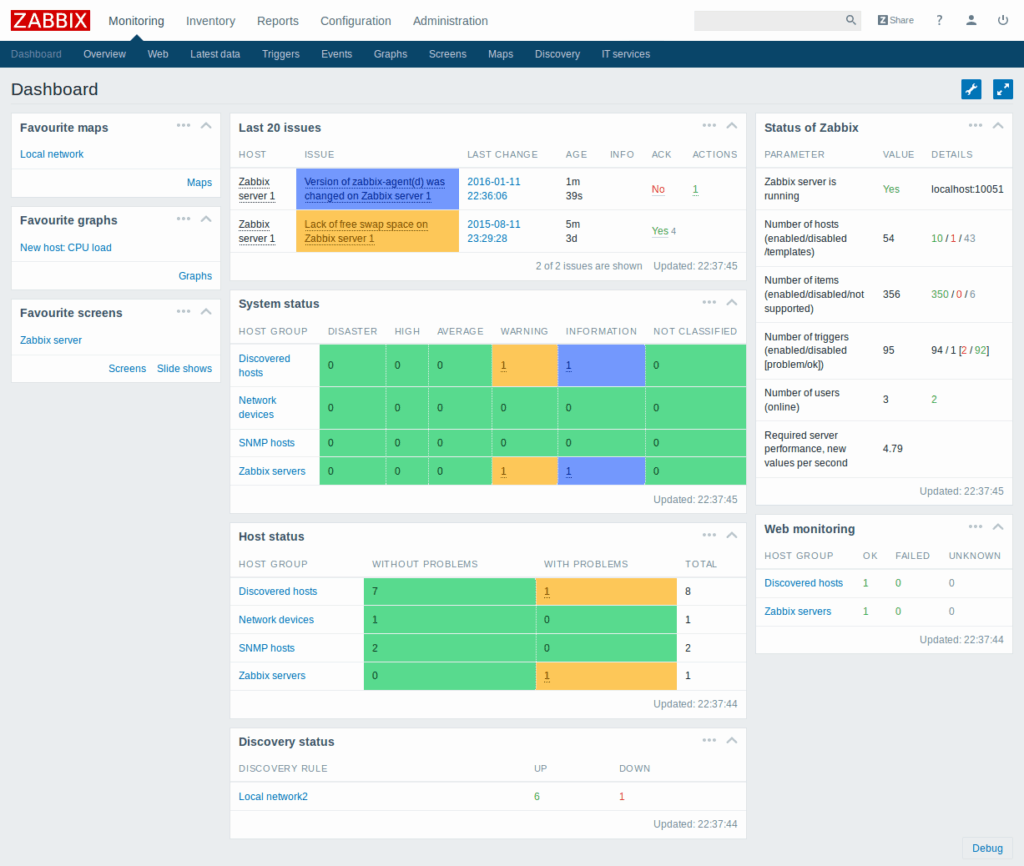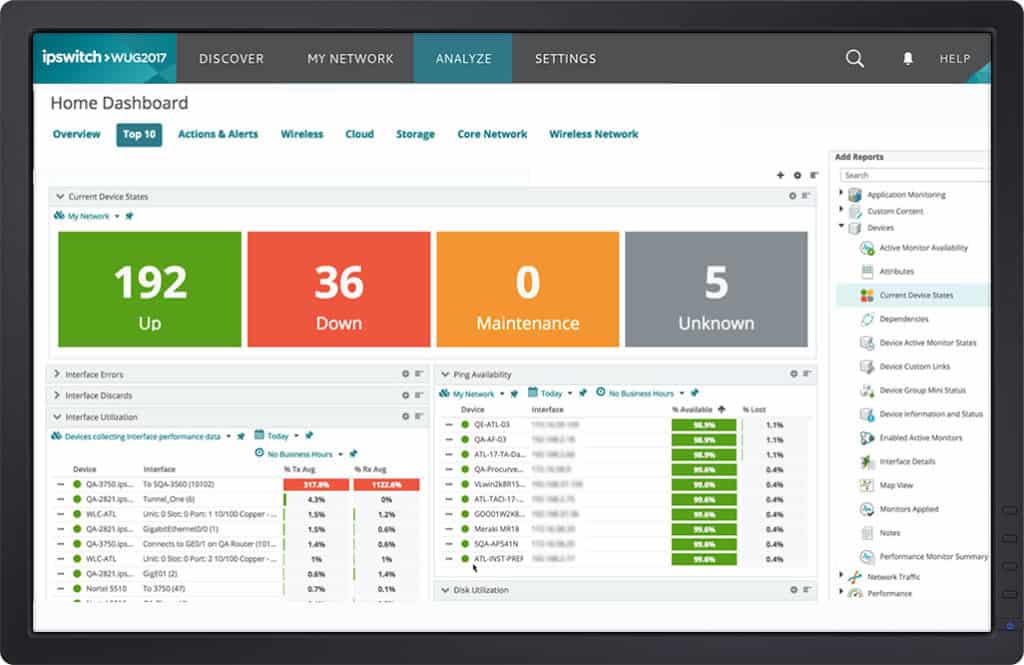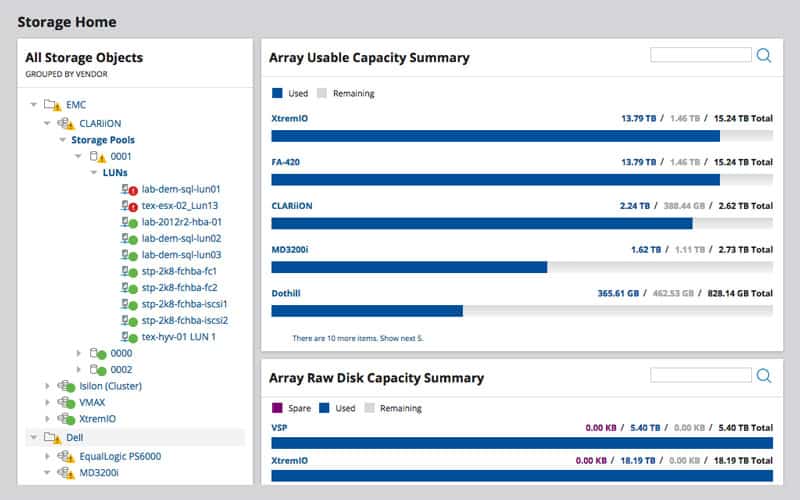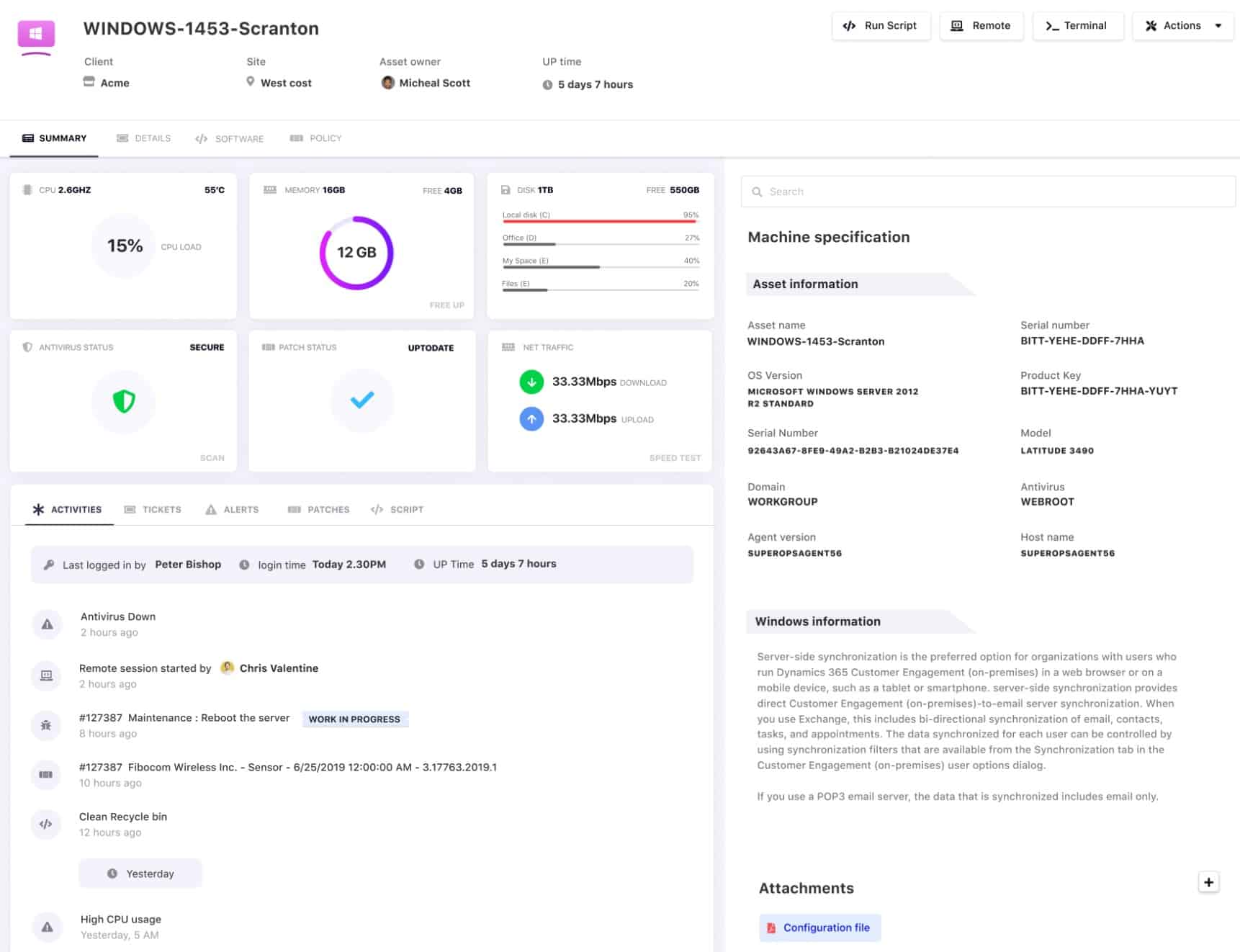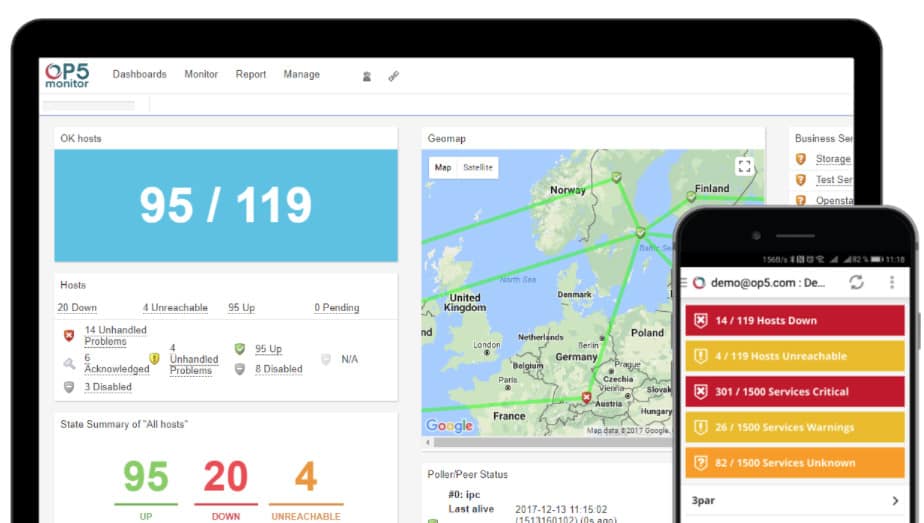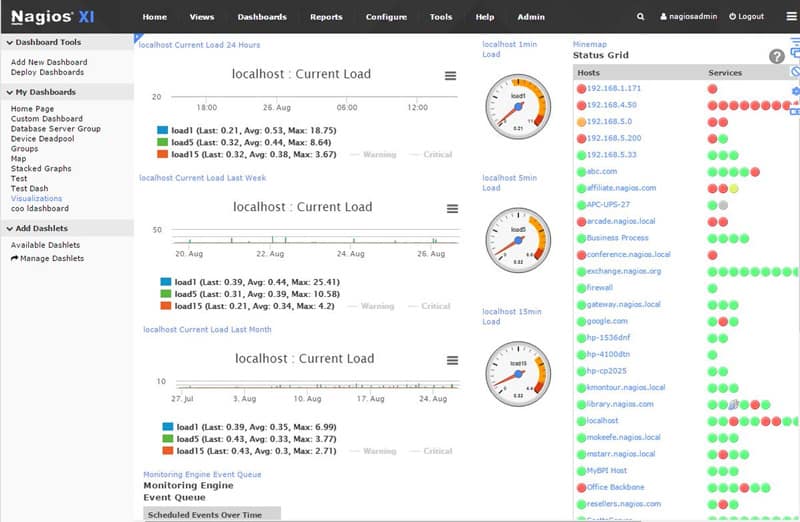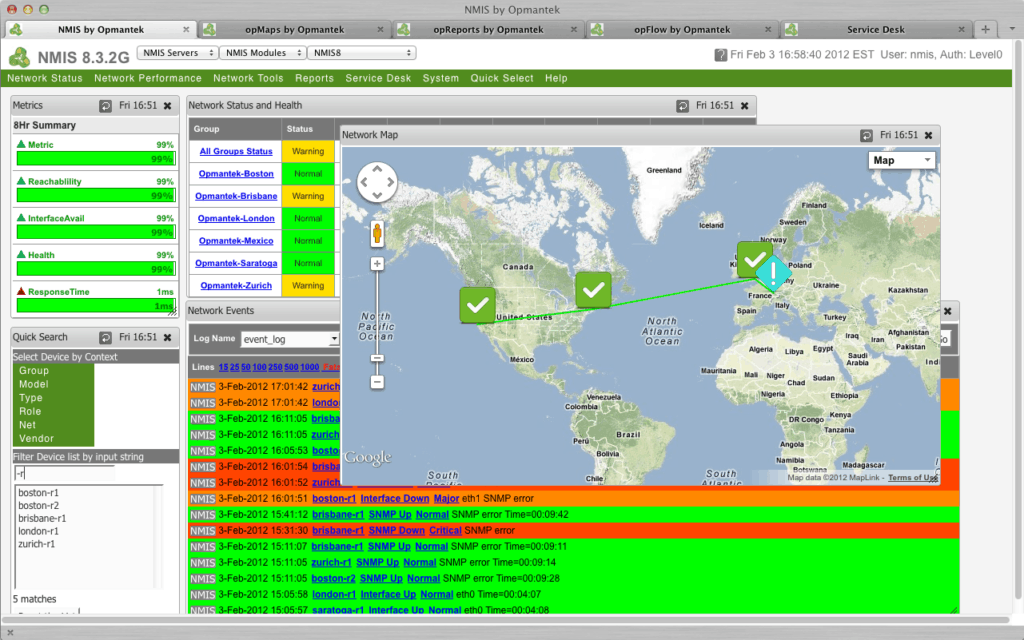Systems Management refers to the enterprise-wide administration of IT systems. It includes a wide array of tasks spanning across different operating systems, applications, and infrastructure.
Here’s our list of the top systems management tools:
- NinjaOne RMM – FREE TRIAL A SaaS remote monitoring and management package that includes a Help Desk ticketing system and is designed for use by IT departments and MSPs. Get a 14-day free trial.
- ManageEngine Applications Manager – FREE TRIAL This software package includes an autodiscovery service that generates an application dependency map. Runs on Windows Server, Linux, AWS, and Azure. Get a 30-day free trial.
- ManageEngine Desktop Central – FREE TRIAL Is a robust enterprise administration platform that excels in managing a wide range of devices including servers, laptops, and mobile devices from a central location. Its extensive compatibility with various operating systems and its ability to automate routine management tasks make it a top choice for large organizations looking to enhance administrative efficiency and security. Start a 30-day free trial.
- Paessler PRTG – FREE TRIAL A package of tools that offers tools to monitor networks, endpoints, and software. Available as a SaaS platform or for installation on Windows Server. Download a 30-day free trial.
- Zabbix A free system monitoring package that can be extended by templates to watch over specific hardware and software. Available for Linux, Docker, virtualizations, and cloud platforms.
- WhatsUp Gold A network monitoring package that can be extended by add-ons to monitor other assets, such as servers and applications. Runs on Windows Server.
- SolarWinds Systems Management Bundle This package of several SolarWinds tools provides server monitoring for physical, virtual, and cloud systems and also provides a log analyzer.
- SuperOps RMM This cloud-based package implements system monitoring and management for MSPs and IT departments with a companion PSA module.
- Op5 Monitor Full stack monitoring for on-premises and cloud systems that can monitor virtualizations as well as physical devices. Runs on Linux.
- Nagios XI A highly-respected system monitoring package for networks, endpoints, and software that can be extended by free plug-ins. Runs on Linux, Hyper-V, VMware, and Docker.
- FirstWave Network discovery and monitoring plus security monitoring with this package that runs on its own VM.
Some of the tasks that come under the Systems Management umbrella include:
- Application lifecycle management
- Help and service desk management
- Data center infrastructure management
- Application performance and service management
- Business system management
- Disaster recovery and backup
- Capacity planning
- Network performance management
- Networking
- System Administration
- Logs
- Automation, and more.
Since Systems Management Encompasses all facets of IT administration, it is important to have the right tools to support and manage this process.
In fact, an effective systems management strategy based on the right software gives rich returns to an organization in the form of quicker delivery of IT systems, especially SaaS systems, faster response to changing business requirements, more control over security and data, and better management of day-to-day operations of the data center.
The Best Systems Management Software
Methodology for Selecting the Best Systems Management Software & Tools
You may find various options when looking for the best system management tools in the market. But to choose the best one, we have listed a few methodologies that you must consider:
- Check if it can create an asset inventory
- Does it offer software license management?
- Can you create logs of technician activities?
Now that we have seen the importance of systems management to an organization, let’s take a detailed look at some of the top tools that can give your organization all the above-mentioned benefits.
Here is a detailed list of features, pricing, and download links for each of these tools and software solutions for Systems Management.
1. NinjaOne RMM – FREE TRIAL
NinjaOne RMM is a cloud-based SaaS platform of remote monitoring and management (RMM) systems for use by managed service providers (MSPs). This package has a multi-tenanted architecture, which means that the MSP can create a separate sub-account for each client.
Key Features
The service management functions in NinjaOne RMM provide a high degree of task automation and its features include:
- System discovery that can cover multiple sites per client
- Documentation of all equipment in a hardware inventory that shows the attributes and capacities of each device
- A software scan of each endpoint that creates a software inventory
- Detection of unauthorized devices connected to the network
- A facility to standardize the software profile of all endpoints
- Automated performance monitoring for networks, endpoints, and applications
- Alerts for performance problems
- Consolidated overviews for multiple sites
- Patch management
- A self-service portal for users to access solutions
- A ticketing system that routes and tracks user support tasks
- A link between system monitors and the team management system that converts performance alerts to tickets
- Time tracking for SLA compliance and billing
- Optional backup and recovery service
- Option security features that include antivirus and drive encryption
Why do we recommend it?
We recommend NinjaOne RMM for its ease of setup and robust performance monitoring. Its features such as system discovery, automated alerts, and optional security measures make it a comprehensive solution for remote monitoring and management.
Who is it recommended for?
NinjaOne RMM is best suited for Managed Service Providers (MSPs) who manage multiple clients and need to maintain a separate sub-account for each. It’s also a great fit for organizations that prioritize security features like antivirus and drive encryption, as well as those in need of robust performance monitoring and alert systems.
Pros:
- Easy to setup and delivers faster results
- Discovers unauthorized devices
- Provides automated performance monitoring
- Sends instant alerts on detecting performance issues
- Offers antivirus and drive encryption for security
Cons:
- Filters and search features need to be improved
You can find out more about bespoke pricing with a direct quote that matches your requirements. You can start the process with a 14-day free trial. NinjaOne is a SaaS platform, so you sign up for the service online.
EDITOR'S CHOICE
NinjaOne is our top pick for a systems management software package because this cloud platform provides both monitoring and management systems that enhance the productivity of support technicians. Cost savings are crucial for the success of managed service providers (MSPs) – a sector where price is a core selling point. The NinjaOne platform provides enterprise-wide administration and monitoring services for entire companies. Each account can be subdivided which suits MSPs that will be managing the systems of many businesses within one NinjaOne account. However, this tool is also suitable for use by the IT department of a single company – in this use case, the support department just wouldn’t implement the sub-account feature. As well as providing monitoring tools for networks, servers, and applications, this package includes automated system management services, such as its patch management unit. The bundle also provides a Help Desk ticketing system, which is fronted by a self-service portal for users that incorporates a knowledge base to reduce the demand on the Help Desk.
Download: Get a 14-day free trial
Official Site: ninjaone.com/rmm/
OS: Cloud based
2. ManageEngine Applications Manager – FREE TRIAL
ManageEngine Applications Manager makes it easy for IT administrators to stay on top of the performance of servers and applications, so problems can be identified quickly and application bottlenecks are reduced.
Key Features
Applications Manager comes with the following features.
- Provides support for Windows, Linux, Solaris, IBM AIX, Mac OS, HP Unix.Tru64 and FreeBSD.
- Monitors more than 100 key performance indicators of your application
- Allows you to group a few applications as a single unit for easy monitoring.
- Discovers and maps applications and their dependencies to give a comprehensive insight into your IT infrastructure.
- Instantly detects anomalies in performance
- Identifies application faults and helps to resolve them before the end user detects it.
- Comes with powerful reports.
- Helps to manage SLAs by monitoring the availability and performance of mission critical applications.
- Offers different editions for the varying needs of every organization
- Provides REST APIs for getting data from Applications manager.
- You can create custom dashboards and do admin activities through a web browser.
- World Map Business View gives a comprehensive understanding of your distributed network.
- Supports multi-user access.
- Available in the following languages: English, German, French, Spanish, Chinese, Korean, Hungarian, Japanese and Vietnamese.
Why do we recommend it?
We recommend ManageEngine Applications Manager for its versatility in monitoring a wide array of performance indicators and its proactive approach in identifying and resolving issues. It excels in reducing application bottlenecks and offers powerful, customizable reporting.
Who is it recommended for?
ManageEngine Applications Manager is recommended for IT administrators who need a comprehensive view of their servers and applications across various operating systems. It’s particularly useful for organizations that require in-depth performance monitoring, real-time alerts, and flexible reporting options to manage Service Level Agreements (SLAs).
Pros:
- Identifies issues and reduces application bottlenecks
- Watch over 100+ KPIs for your application
- Instantly detects and remediates server issues
- Generates insightful reports
- REST APIs help obtain data from the Applications Manager
Cons:
- Exploring all functions can be time-taking
- Limited agents are available
There are two editions – Professional and Enterprise. The cost depends on the capabilities/tools you wish to add to your bundle. You can take a detailed look at the price of different components one you register for a 30-day free trial.
3 ManageEngine Desktop Central – FREE TRIAL
Desktop Central is a comprehensive enterprise administration platform designed for managing servers, laptops, desktops, smartphones, and tablets from a central location. It is highly effective for automating routine management tasks across Windows, Mac, and Linux operating systems, ensuring devices stay secure and up-to-date.
Key Features
- Patch Management: Automates the deployment of patches and updates across diverse OS platforms.
- Software Deployment: Streamlines the installation of software from a central dashboard.
- Remote Control: Facilitates remote access and control of desktops for troubleshooting.
- Asset Management: Keeps track of hardware and software assets within the organization.
- Configurations: Provides over 25 pre-defined configurations for managing system settings.
- User Administration: Simplifies the management of user groups and permissions.
- Mobile Device Management: Ensures enterprise mobility by managing mobile devices effectively.
- OS Deployment: Automates the process of deploying operating systems to new devices.
Pros:
- Centralized Management: Offers a single console for managing all end-user devices, enhancing administrative efficiency
- Extensive Compatibility: Supports a wide range of operating systems, making it ideal for diverse IT environments
- Robust Security Features: Enhances network security with comprehensive patch management and real-time system monitoring
- User-friendly Interface: Features an intuitive interface that simplifies complex administrative tasks
Cons:
- Resource Intensity: May require significant system resources to run effectively, potentially impacting older hardware
- Complex Initial Setup: The initial setup process can be complex, particularly in large and diverse environments
Why do we recommend it?
We recommend Desktop Central for its robust suite of management tools that automate and streamline enterprise administration tasks. Its ability to manage a diverse range of devices and operating systems from a single console makes it invaluable for large organizations.
Who is it recommended for?
Desktop Central is ideal for large enterprises and IT departments that require a powerful, centralized solution for managing a large number of devices across different geographical locations. It’s particularly beneficial for organizations with mixed-device environments and those seeking to minimize IT overhead.
4. Paessler PRTG – FREE TRIAL
PRTG Systems Management Software from Paessler is a great choice for monitoring, maintaining and provisioning computer networks. It helps to monitor a whole range of different parameters such as bandwidth, availability, and performance.
Key Features
The features of Network Management Software are:
- Monitors how much traffic is generated by each computer/application. Knowing this traffic congestion will help you plan better.
- Continuously checks the availability of devices
- Monitors performance and load using many parameters such as network speed, CPU usage, RAM load and more.
- Generates comprehensive reports
- Comes with more than 200 sensor types, using which, you can monitor anything in your network.
- Supports SNMP, WMI, packet sniffing, FTP, HTTP and other protocols.
- Keeps downtime to a bare minimum, detects malware attacks and evenly distributes loads
Why do we recommend it?
We recommend Paessler PRTG for its comprehensive monitoring capabilities that cover everything from bandwidth and availability to performance metrics like CPU usage and RAM load. Its extensive range of sensor types and real-time threat detection make it a robust choice for any network.
Who is it recommended for?
Paessler PRTG is ideal for IT professionals who require a multi-faceted approach to network monitoring and management. This tool is particularly well-suited for businesses that need to keep a constant eye on multiple parameters, such as bandwidth usage, performance metrics, and security threats, to ensure minimal downtime.
Pros:
- Allows tracking performance, bandwidth as well as availability
- Measure the volume of traffic generated by each device
- You can track CPU usage, RAM load as well as network speed
- Provides access to 200+ sensor types
- Identifies threats in real-time
Cons:
- Integrating sensors requires technological expertise.
- Designed keeping only IP professionals in mind
Pricing depends on the number of sensors you use. The first 100 sensors are free. The remaining are priced as follows.
- 500 sensors – $1600
- 1000 sensors – $2850
- 2500 sensors – $5950
- 5000 sensors – $10500
There are two other plans that allow you to use unlimited sensors. The first plan allows only one installation and is priced at $14500 while the second allows five installations and is priced at $60000.
You can download the software on a 30-day free trial. You get to use the first 100 sensors for free!
5. Zabbix
Zabbix is a comprehensive tool that monitors anything in your network such as servers, clouds, applications, services, databases, storage devices, virtual machines and more. The best part – Zabbix is a free and open-source software, so there are no hidden costs or fees associated with it.
Key Features
The features of Zabbix are:
- Collects and analyzes metrics from any device.
- Supports SNMP, IPMI agents, and other custom methods
- Offers agentless monitoring of user services.
- Detects problem states from the incoming metric flow automatically
- Offers highly flexible definition options
- Comes with a native web interface that gives you the option to present information in many formats to suit your needs and preferences.
- Provides a visual overview through drill-down reports, slideshows, graphs, and network maps.
- Scans a network periodically, discovers devices, and maps them automatically.
- Automatically creates triggers, items, and graphs for different elements.
- Scales well and at the same time, gives centralized control.
- Allows to remotely run custom scripts on monitored hosts.
- Integrates well with most devices and environments, thanks to a flexible API.
Why do we recommend it?
We recommend Zabbix for its all-encompassing monitoring capabilities that range from servers and clouds to storage devices and applications. The platform’s ability to automatically detect issues and its open-source nature make it a cost-effective and smart choice.
Who is it recommended for?
Zabbix is recommended for organizations of all sizes that are looking for a one-stop solution for network monitoring. Its versatility and scalability make it an excellent choice for businesses that have a mix of old and new technologies and are looking for a tool that can seamlessly integrate with both.
Pros:
- Allows tracking servers, databases, applications, and even storage devices
- Automatically identifies issues from the incoming metric flow
- Generates drill-down reports and network maps to provide a visual summary
- You can run custom reports remotely on monitored hosts
- Periodically runs network scans and maps devices automatically
Cons:
- Depends on the community for bug solutions
- Tracking multiple devices can make the interface feel crowded.
Zabbix is 100% FREE.
6. WhatsUp Gold
WhatsUp Gold from Progress helps to proactively monitor your infrastructure and the many devices and applications that are a part of it.
Key Features
The features of WhatsUp Gold are as follows.
- Automatically discovers and maps devices.
- Comes with a top-notch alerting system
- Custom reports and dashboards give you an in-depth peek into the performance of your devices at any time.
- Monitors cloud-based devices as well
- Has a flexible email scheduling and distribution system. Supports SMTP authentication.
- Offers customizable device roles.
- Supports over 200 Cisco MIBs for monitoring Cisco equipment
Why do we recommend it?
WhatsUp Gold stands out for its proactive monitoring of both on-premises and cloud-based devices, as well as its robust alerting system. Its support for over 200 Cisco MIBs makes it particularly useful for monitoring Cisco equipment.
Who is it recommended for?
WhatsUp Gold is ideal for IT teams that manage a mix of on-premises and cloud-based resources. It’s particularly useful for organizations using Cisco equipment that would benefit from specialized monitoring capabilities.
Pros:
- Monitors applications, devices, and infrastructure proactively
- You can also watch over cloud-based devices
- To track Cisco equipment, you can access 200+ Cisco MIBs
- Manages networks, traffic, and VMs using the customizable dashboard
- Reducing MTTRs is made easier with intuitive processes
Cons:
- Bulk editing is time-consuming
- Java’s ability to retrieve data from a database and create pages takes a long time.
You can get a quote and download a free trial version.
7. SolarWinds Systems Management Bundle
SolarWinds is one of the leading companies in systems management, and it has more than ten licensed products to handle specific aspects of systems management. Some of these tools include the following.
- Server & Application Monitor
- Virtualization Manager
- Storage Resource Monitor
- Server Configuration Monitor
- Application Performance Monitor
- Web Performance Monitor
- Log Manager for Orion
- Access Rights Manager
- SolarWinds Backup
- ipMonitor
Besides these individual products, SolarWinds also offers three bundled systems management products and they are: Systems Management Bundle, Log and Systems Performance Pack and Application Performance Optimization Pack.
Let’s take a quick look at the features of these systems bundles to give you an idea of what they can offer for your organization.
Key Features
The features of the SolarWinds Systems Management bundle software package are:
- It includes Server and Application Monitor, Virtualization Manager, Storage Resource Monitor and Web Performance Monitor.
- Easy to install and you can get going within just 30 minutes.
- Monitors infrastructure for both Azure and AWS
- Comes with more than 1200 templates for systems and application performance monitoring
- Maps infrastructure and application dependencies
- Comes with built-in virtualization monitoring
- Monitors server storage volumes, disk usage, and capacity metrics. This information is particularly useful for capacity planning.
- You can create custom monitors, edit existing templates, and import custom scripts.
- Powered by the scalable SolarWinds Orion platform.
- Offers centralized asset management, so you can remotely manage the software and hardware located across different systems and workstations.
- Allows you to drag, drop, and overlay performance metrics to get a detailed look.
- Comes with comprehensive reports to meet all your needs.
- Supports hybrid cloud environments
- Automatically discovers applications and infrastructure.
Why do we recommend it?
We recommend the SolarWinds Systems Management Bundle for its comprehensive suite of tools that cover everything from server and application monitoring to storage and web performance. Its ease of installation and extensive template library make it a versatile solution for diverse IT environments.
Who is it recommended for?
The SolarWinds Systems Management Bundle is ideal for medium to large enterprises that operate in hybrid cloud environments. It is particularly useful for IT teams that require a centralized solution for managing multiple aspects of their systems, such as application performance, server configurations, and storage resources.
Pros:
- Helps scan your network for apps and infrastructure automatically
- Uses PerfStack dashboard to track performance
- Offers access to 1,200+ infrastructure monitoring templates
- Simply build your own dashboards and reports using customizable widgets
- Send alerts/notifications via SMS or email
Cons:
- Not a great solution for non-technical users
Download a 30-Days free trial.
8. SuperOps RMM
SuperOps RMM is a cloud platform that offers SaaS packages for remote monitoring and management (RMM) and professional services automation (PSA). The RMM system includes full-stack system monitoring that is controlled from a cloud-based console.
Key Features
The SuperOps RMM system provides the following services:
- Multi-site monitoring and a multi-tenant architecture for MSPs
- Automated monitoring for networks, endpoints, and software
- Alerts for performance problems
- Device discovery and inventory creation
- Software license management
- Patching for Windows, macOS, and software packages
- Software deployment
- Task automation
- Scripting for task automation
- IT documentation service
- Compliance reporting
- Associated PSA with a ticketing system
Why do we recommend it?
We recommend SuperOps RMM for its comprehensive full-stack system monitoring and automation features. The platform’s multi-tenant architecture and multi-site monitoring capabilities make it especially valuable for Managed Service Providers (MSPs).
Who is it recommended for?
SuperOps RMM is ideal for MSPs and IT teams in small to medium-sized enterprises that are looking for a cloud-based, all-in-one remote monitoring and management solution. It’s also beneficial for organizations that need robust compliance reporting and software license management.
The SuperOps plans that include the RMM package are:
- Standard RMM-only for $79 per technician per month
- Pro for $99 per technician per month
- Super for $129 per technician per month
These rates apply to the annual payment plan.
Sign up online for a 14-day free trial.
9. Op5 Monitor
Op5 Monitor is an enterprise-level monitoring solution from Op5. It monitors applications, networks, servers and storage, regardless of whether it is on-premise or in a private/public cloud. Supports hybrid environments too.
Key Features
The features of Op5 Monitor are:
- Has the capability to handle large volumes of devices.
- User-friendly interface
- Robust solution that works well in large environments too.
- Dashboards are fully customizable and interactive.
- Highly scalable for distributed environments
- Offer many automation options to meet the needs and preferences of your organization
- Comes with a developer-friendly API for extension.
Why do we recommend it?
Op5 Monitor excels in managing large volumes of devices and offers a robust solution suitable for large environments. Its highly scalable, distributed architecture and developer-friendly API make it a versatile choice for diverse IT setups.
Who is it recommended for?
This tool is perfect for large enterprises with complex, hybrid IT environments. It’s particularly beneficial for organizations looking to automate and integrate their monitoring solutions into existing systems.
Pros:
- Manages large volumes of devices
- Control the entire IT estate from a single console
- Rest API support enables automation and system integration.
- Generates service level reports and visually displays all the data for monitoring
- Offers a distributed architecture that can manage any environment, regardless of size or type
Cons:
- More compliance-based reporting features may be great
- You need to send requests to the platform for quotes
Visit their website to get a custom price. You can download a free version from here.
10. Nagios XI
Nagios XI is a comprehensive application, network and service monitoring solution for today’s complex IT environments.
Key Features
The features of Nagios XI are as follows.
- Monitors bandwidth usage to give you a list of the most bandwidth consumers.
- Provides real-time analytics
- Monitors servers, SLAs, IP address, Internet usage and uptime
- Reports the performance and availability of different devices
- Provides high levels of efficiency and scalability
- Dashboards can be customized to meet individual preferences
- Works well for distributed environments too.
- Custom scripts can be added its use
Why do we recommend it?
Nagios XI offers a comprehensive monitoring solution with high levels of efficiency and scalability. It excels in providing real-time analytics and customized dashboards, making it a strong choice for monitoring complex IT environments.
Who is it recommended for?
This tool is ideal for medium to large-sized enterprises that need to monitor a variety of application, network, and service metrics. Organizations looking for high customization and the ability to scale their monitoring solution will benefit greatly from Nagios XI.
Pros:
- Watches over all mission-critical infrastructure elements
- Sends alerts on discovering issues and outages
- Gives a centralized view of business processes and IT operations
- Allows generating capacity planning graphs
- Users can save and archive recent configurations
Cons:
- Installation may be technically challenging.
- More integrations with extra ticketing systems would be nice
Pricing: Starts from $1,995.
Download a trial version.
11. FirstWave
FirstWave is an intelligent network management system that helps with the configuration, compliance, auditing and discovery of all networks, both big and small. Since it is built on top of open source cores of Open Audit and NMIS, it can be tailored to meet any business environment.
Key Features
The features of FirstWave are:
- Monitors and manages your complete IT infrastructure, including hybrid infrastructure and emerging architectures such as containers and micro-services.
- Supports standards-based compliance management
- It can be up and running within just a few minutes.
- The open-source cores can be extended through plug-in modules, so you can have a custom solution that works great for your organization.
- Operates in diverse environments.
- Automatically detects, audits, and manages any network-connected device.
Why do we recommend it?
FirstWave stands out for its quick setup and its ability to support limitless integrations. Built on open-source cores, it offers high customizability through plug-in modules, making it a flexible solution for network management.
Who is it recommended for?
This tool is well-suited for businesses of all sizes that are seeking a highly customizable and quickly deployable network management solution. It’s particularly advantageous for organizations that operate in diverse environments and require standards-based compliance management.
Pros:
- Hardly takes any time to configure and run operations
- Supports limitless integrations
- Automation helps in managing repetitive operations
- Runs audits and manages network-connected devices and applications
- Uses plug-in modules to extend open-source cores
Cons:
- Only the pricey edition offers access to advanced features.
- Technical knowledge is essential for proper configuration
You can book a demo of the software.
Conclusion
To conclude, systems management is a fundamental part of every IT system as it ensures that your devices are up and running, there are no security breaches, your operations are in compliance with existing industry standards, and more. It is essential for the success, security, and growth of your organization.
We hope the above-mentioned tools give you an idea of what they can do for your organization, so you can make informed choices when it comes to choosing the right systems management tool that is ideal for your business environment.
Related Posts:
Best VM Manager & Monitoring Software
Storage Management Software – What is it and How to Implement it

